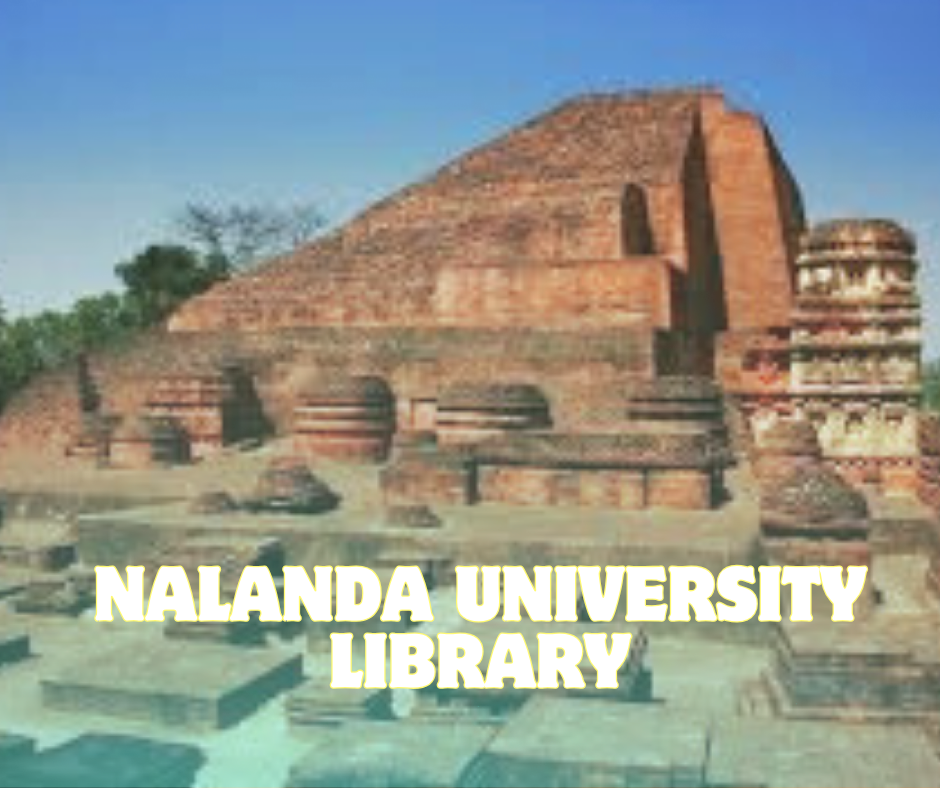A library is a social institution. A library collects, preserves, and distributes the creative works of socialized people. Since the dawn of human civilization, some social institutions have influenced people in their contemporaries and later times, through which libraries are remembered as the brightest. Throughout the ages, libraries have been built by a single individual or by the joint efforts of a tribe. One such library, which was built by the Buddhist community, is the Nalanda University Library. This library is one of the libraries that came forward in the council of knowledge of human society in ancient times.
Origin and location (643 to 626 BC):
Nalanda is a famous historical place in the Patna district of the present-day Bihar state of northeastern India. A small railway station is located in Bakhtiarpur Rajgir, which is part of the Patna district. Nalanda is located ten kilometers north of this railway station. Nalanda is famous for its ancient Buddhist ruins. The newly built Nalanda University of present-day India was established here in 1951. Gautama Buddha, the father of Buddhism, visited the place several times. The family home here was his favorite residence. It is also said to be the birthplace of Mariputra, one of the Buddha’s disciples.
According to Tibetan historian Lama Taranakho, the Mauryan emperor Ashoka worshipped the Chaitya of Mariputra and built a temple here. At that time, there were libraries in monasteries and temples, and numerous private libraries emerged from that time.

Importance of Nalanda University:
Importance of Nalanda University Library The role of Buddhist knowledge in the practice of scriptures was not as narrow as that of the Brahmins. Buddhist monasteries were the educational system of all religions. Nalanda is called one of the best centers of study of Buddhism in South Asia. For this reason, it is known as the Mahavihara of Buddhism. Nalanda began to gain real importance in the fifth century. At that time, the Gupta dynasty ruled. According to the account of Hiuen Tsang, five princes were the founders of the Sangha. At that time, Nalanda occupied an important place in the spread of education. With the help of the monks here, the fame of Nalanda spread throughout the world. At that time, Nalanda was considered one of the leading centers of learning in the Buddhist world. The influence of Nalanda lasted until the 20th century.
At that time, students from different countries of the world including Asia used to come to the Buddhist monastery of Nalanda to study. Students from countries like Tibet, Thailand, Nepal, and Burma did not just come to study but also to translate various books. It is said that the Chinese traveler Ti-Tsing translated the original manuscripts of 400 cultures from here, which was a collection of five lakh poems. Moreover, he made copies of more than 200 manuscripts and took them back to the country. According to one estimate, at that time 10,000 students could eat, study, and stay free of cost. Moreover, there were fifteen hundred teachers/scholars in this great monastery at that time. The famous Chinese traveler Yuan Tsang was a student here during his visit to India. Bengali scholar Shilbhadra was the principal here several times. Another Bengali scholar named Shantirakshit was a professor here and taught here for a few days during his visit to India. The students, teachers and laboratories here carried out their research work with great efficiency. The environment here stirred their souls. This library is a symbol of a major heritage of India which has now become a tourist destination. As a result, this institution has gained international recognition today. Nalanda University Library is one of the oldest libraries in the world.
Library Writing Materials/Materials:
Writing was introduced in India from 1000 BC. As a result, libraries were established soon after this. Indian scholars, researchers, sages and sages used to permanently record their thoughts, language, and emotions on metal materials, stones, leaves, cassava leaves, palm leaves, etc. Here, the catalog was made of palm leaves. Manuscripts were collected and preserved by the library, which was known as Bagdevibhandar at that time. Most of the reading materials were made of palm leaves, wrapped in cloth and tied with thread and kept on bricks or stones. Students used to read while sitting on the floor. All those books and papers of the Buddhist era were collected and made into the Nalanda Library in the 712th century.
Introduction to the Library Building:
From the descriptions of Chinese travelers, it is known that a vast area was reserved for the library building. The library building was multi-storied and it was built according to a proper plan. The names of the three notable buildings among them were respectively –
a. Ratna Sagar – which is six storied (possible)
b. Ratna Sambhava – which is nine storied
c. Ratna Ranjaka – which is six storied (possible)
The library had a separate room for research. That captivating atmosphere still excites the souls of researchers/knowledge seekers worldwide
Library Collection:
Most of the collections of the Nalanda University Library were original books related to Buddhism and related books. Moreover, the books that increased the fame and importance of Nalanda were the Vedas, philosophy, literature, medicine, astrology, etc. Most of the collected materials were bound in cloth and written on palm leaves.
Library Material Classification and Arrangement System:
The collections of Nalanda University Library were arranged thematically and indexed. The arrangement of the entire material attracted both domestic and foreign visitors. As a result, they themselves would stay there for years and translate and copy many valuable books.
Destruction of the Nalanda University Library:
In the first part of the 13th century (1204 to 1205), the Mahavihara was destroyed during the invasion of Bangladesh by Bakhtiyar Khalji. With this, the library was wiped out. According to some, it was destroyed by Turkish troops during the Turkish invasion of the thirteenth century. The library associated with it was burnt down. In 1660 AD, Alexander Cunningham identified its ruins and discovered antiquities at the archaeological site near the village of Bargaon. A museum was opened with the archaeological finds found in the excavations. Which has developed into a center for the preservation of Buddhist memory and higher research on Buddhism. This museum still holds the heritage of the Nalanda University Library, which reminds us of the past.
Nalanda University Library is undoubtedly one of the few institutions that came forward in the spread of knowledge in ancient times. The help that Nalanda University provided not only in the spread of knowledge but also to students and teachers is rare in the history of all time. Finally, it can be said that if some other institutions had come forward like Nalanda University Library, the successful form of the present civilization would have risen to many more parts.




The library is one of the greatest library in world
yes.